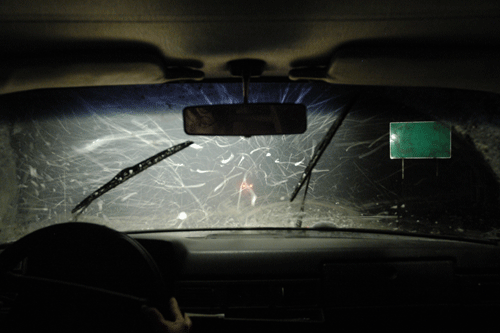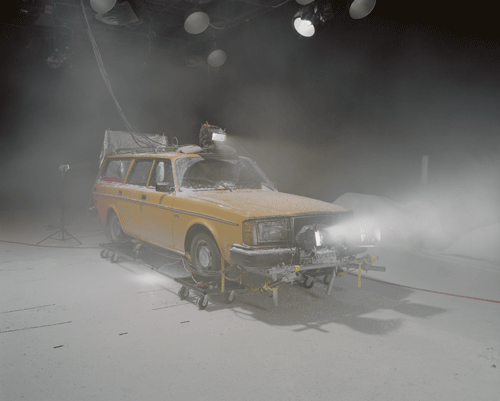Near
Miss, 2005
35mm color film with sound transferred to DVD, 5:25 min.
Near
Miss is the second in a series of new works dealing with perception, coincidence,
and the phenomenology of memory. Insofar as the film is an attempt to reenact
an undocumented event witnessed only by its director ten years past, the work
touches on the problems associated with the objective communication of subjective
memory.
Near Miss consists of three nearly identical cinematic “takes.”
In each, the camera is positioned inside a car that appears to be driving late
at night though a snowstorm. Highway markers and a road sign slip by on the right,
and the red tail-lights of another car can be seen in the distance on the road
ahead. After about a minute, the car begins to lose traction, fishtails, then
spins around to face the way it came, sliding backwards until it finally comes
to a stop. The image cuts to black, and after several seconds, another take begins.
Each take is accompanied by its own unique sound track, and each reveals subtle
differences in the details of its execution.
Accompanying the film, but
never in the same space, is a large color photographic production still of an
orange Volvo station wagon, raised up on dolly wheels and elaborately outfitted
with lights and cables, inside a film studio. The room is filled with the hazy
residue of fog and snow machines. In the background, artificial snow banks and
a prop sign can be seen.
Also exhibited in conjunction with the film is one or more from a series of texts that describe the original event depicted in the film as understood by different members of the film’s production team: the camera operator, special effects crew, sound designer, etc. Each text offers a different “take” on what originally transpired, none with any greater authority than the others. These may be included in the exhibition in any number of ways. For one exhibition, a text might be sent on postcards announcing the show; for another exhibition, a text might accompany the official press release; for a third, a text might be printed on the gallery wall along with the film’s production credits, or memorized and recited by the gallery staff or exhibition curator. The artist/director’s version is never included among these texts: it can be understood as the cumulative effect of the collaborative effort manifested in the film itself.
| | |
Near
Miss, 2005
Film 35 mm couleur et son, transféré sur DVD,
5 mn 25 s
Near Miss est la deuxième d'une nouvelle série
d'œuvres, qui traitent de la perception, des coïncidences et de la phénoménologie
de la mémoire. Dans la mesure où le film tente de reconstituer un
événement survenu voilà dix ans sans autre témoin
que la cinéaste elle-même, il soulève la question de la communication
objective de souvenirs subjectifs.
Near Miss se compose de trois
prises de vues quasi identiques. Chaque fois, la caméra est placée
à l'intérieur d'une voiture qui semble rouler dans la nuit sous
une tempête de neige. Des balises d'autoroute et un panneau de signalisation
défilent sur la droite, tandis que l'on aperçoit au loin les feux
arrière rouges d'une autre voiture. Au bout d'une minute environ, la voiture
commence à déraper, fait une embardée, puis un tête-à-queue
et recule avant de s'arrêter enfin. L'écran devient noir pendant
plusieurs secondes, après quoi, une autre prise commence. Chaque prise
s'accompagne d'une bande-son différente, et chacune révèle
de subtiles variations dans les détails de sa réalisation.
Le
film est présenté en même temps, mais jamais dans le même
espace, qu'une grande photo de tournage en couleur où l'on voit un break
Volvo orange monté sur un chariot de travelling et équipé
de tout un dispositif compliqué de câbles et projecteurs, à
l'intérieur d'un studio de prise de vues. La salle est pleine de résidus
vaporeux produits par les machines à neige et à brouillard. Dans
le fond, on découvre les talus de neige artificielle et un faux panneau
de signalisation. | | |

